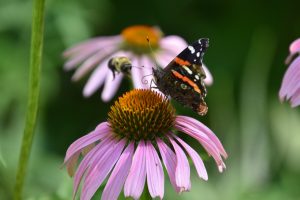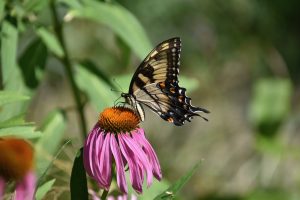The Homegrown National Park™
Many thanks to Gina Anderson, Purdue University Extension Educator for Floyd County, for organizing a wonderful online live Q&A session this week with Dr Douglas Tallamy, Professor of Entomology at Delaware University.
The INPS Landscaping with Natives Team have been so inspired by Dr Tallamy’s work, and in particular his most recent book, Nature’s Best Hope and his idea of the “Homegrown National Park™.” This concept brilliantly captures many of the larger conservation goals and makes them both accessible and attainable.
Native plant communities support a great deal more biodiversity than introduced plants, and biodiversity is incredibly important for a stable ecosystem.

© C. Palmer
The greater biodiversity supported by native plant communities is primarily due to specialized relationships that have evolved between plants and insects, driven largely by the evolution of plant defenses to herbivory and insect adaptations to these. Around 90% of insect herbivores are diet or host-plant specialists, meaning that they can only eat or live on plants that they have developed a relationship with through evolutionary time.
This has consequences throughout the ecosystem. For example, a 2018 study found that there were 68% fewer caterpillar species, 91% fewer caterpillars, and 96% less caterpillar biomass in study areas with introduced plants compared to native hedgerows. Caterpillars are one of the most important food sources for many wildlife species and the reduction in caterpillar numbers impacts food availability; another study found that suburban yards dominated by introduced plants were 60% less likely to have breeding chickadees compared to primarily native landscapes. The steep decline in bird numbers across the US has been well publicized, and the widespread use of non-native landscaping plants is a contributing factor.
While non-native plants can provide some ecosystem functions, there is almost always a loss in biodiversity when they are used in place of natives. The conservation of biodiversity is critical – ecosystems and trophic interactions are incredibly complex; we have limited understanding of even the most well studied species interactions, and there are countless others that we have little to no knowledge at all of; we just don’t know where the ‘breaking point’ for ecosystems are. Not only do we risk losing individual species when we destroy habitat but we also risk cascading effects, the loss of multiple interdependent species and the breakdown and loss of entire ecosystems. Biodiversity also encompasses the genetic diversity found within populations that is so vital for their adaptability and ongoing evolution. This is becoming even more critical as fragile populations face increased pressures from climate change and loss of natural habitats through rapid development.
For many people, the conservation of other species is in itself a strong enough argument for action, but even for those who perhaps aren’t concerned with conservation, we can also look at it from a very anthropocentric view. Humans are completely dependent on the ecosystem services provided by plants and animals. (This is rather brilliantly and succinctly described in E. O. Wilson’s 1987 paper, The Little Things that Run the World in which he states ‘..if invertebrates were to disappear, I doubt that the human species could last more than a few months’.) Plants, and native plants in particular, are the foundation of ecosystems on which all of life depends.
A Responsibility – and Opportunity – For Us All: The Homegrown National Park™

© C. Palmer
In his wonderful Half Earth, E.O. Wilson argues that time is running short and we need to act quickly to stabilize the biosphere. He puts forward the argument that by saving – setting aside as a natural reserve – half the Earth, we could stabilize 80% of its species. This is an amazing goal, and something that it is wonderful to strive towards. However in reality, achieving this, particularly without the political will, can sometimes seem unattainable.
The brilliance of Dr Tallamy’s approach, and the Homegrown National Park™ idea, is that it takes the teachings and ethics of Aldo Leopold and E.O. Wilson and looks at how we can achieve their goals within the constraints of the world we find ourselves in.
Looking at the situation as it is today (where, for example, in the US more than 83% of land is under private ownership, and where globally only 17% of the Earth’s land surface is preserved), Tallamy does not diminish the critical role of public preserves, but argues that, on their own, they will not be enough to sustain biodiversity. We need to find ways for nature to thrive in human-dominated landscapes. He expands the opportunity and the responsibility for this ‘necessary task of restoring ecological function to the land’ to all of us and provides a framework for how we can realistically do this.
Dr Tallamy’s approach is excellently summed up by this paragraph from Nature’s Best Hope: ‘We need a new conservation toolbox, packed with more expansive tools. New knowledge will be our most important tool, followed by a cultural recognition that conservation is everyone’s responsibility – not just those few who make it their profession. Every day we are learning more about how to redesign both public and private landscapes in ways that meet the aesthetic, cultural and practical needs of humans without devastating the resources needed by humans and other species. We are learning how to convert at least half of the area now in lawn to attractive landscapes packed from the ground to the canopy with plants that will sustain complex food webs, store carbon, manage our watersheds, rebuild our soils and support a diversity of pollinators and natural enemies. In other words, we are learning how to create landscapes that contribute to rather than degrade local ecosystem function.’
What is so encouraging is that, as Tallamy states, it empowers each of us and also ‘shrinks the problem’ to something that may be manageable. With so many environmental concerns worldwide, and with so many of our plant and wildlife populations declining and facing increasing threats, using our wonderful, diverse native plants in landscaping is a way we can all do something and really make a difference. Together, our gardens and community areas can all be part of the Homegrown National Park™.
So many of the problems we are facing seem out of our control, but we can individually and collectively actually do something that will matter. Also, while so many of the steps that we know we need to take to live more sustainably involve perhaps challenging behavior changes or reducing our resource consumption, this is one area that doesn’t involve restraint. We can increase our use of native plants, make spaces more beautiful and enjoyable, encourage more wildlife – it is a positive in every way!

© C. Palmer
The INPS Landscaping with Natives Team are collaborating with the Indiana Wildlife Federation to bring together a range of material to help homeowners and communities do this – currently in development and launching over the next couple of months. Please do contact us at landscape@indiananativeplants.org if you might like to be involved or if you have any questions!
—Coralie Palmer, INPS Landscaping with Natives Team

